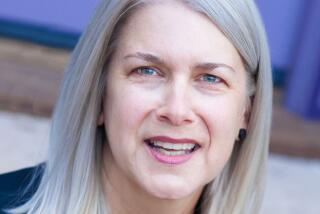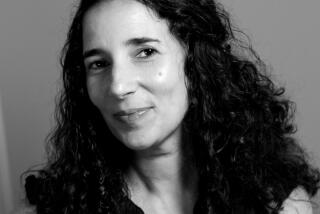More not-to-be-missed nonfiction
“What the Eyes Don’t See: A Story of Crisis, Resistance, and Hope in an American City” by Mona Hanna-Attisha (One World, $28)
“This is the story of the most important and emblematic environmental and public health disaster of this young century,” writes pediatrician Hanna-Attisha, known as “Dr. Mona” in Flint, Mich., who exposed the city’s poisonous water supply. An Iraqi immigrant who fled with her family to the U.S. after her father became an outspoken critic of Saddam Hussein, Hanna-Attisha followed in her father’s footsteps, practicing medicine on the front lines in one of the poorest parts of America. She built a convincing case about high levels of lead contamination in Flint’s water and rallied an action campaign. In her determined and spirited memoir, she argues that the Flint crisis was “entirely preventable” and reflected disregard for the poor by local and state officials.
“One Life at a Time: An American Doctor’s Memoir of AIDS in Botswana” by Daniel Baxter (Skyhorse, $27.99)
In his previous memoir, “The Least of These My Brethren: A Doctor’s Story of Hope and Miracles on an Inner-City AIDS Ward” (1997), Baxter recounted his experience as a physician in New York’s Hell’s Kitchen, treating patients in a crowded, dirty hospital. Five years later, he set off for Botswana, where 24% of the population was infected with HIV. Baxter candidly relates learning from his patients in his eight years there and reproaching himself for being a “self-appointed, putative do-gooder,” unable to grasp the idea that a gravely ill person was considered “an albatross, a burden” and that he couldn’t impose the American idea of “the value of each human life” in a world where resources were so limited. In his bittersweet memoir, Baxter emerges as a deeply empathetic humanitarian who listens carefully to the stories of others.
“Flash: The Making of Weegee the Famous” by Christopher Bonanos (Henry Holt, $32)
From what is now Ukraine where he began as Usher Fellig to Ellis Island and the Lower East Side, the man who took the name Weege is the subject of Bonanos’ new biography. Weegee, declared himself “the world’s greatest living photographer” for his often gritty images of New York City’s streets and crime scenes. Bonanos, city editor of New York magazine and author of “Instant: The Story of Polaroid,” captures the self-mythologizing photographer with his Speed Graphic camera beating the competition to depict accidents and disasters — as well as high society — of 1940s New York with his distinctive noir touch. Bonanos ferrets the truth out of Weegee’s unreliable 1961 autobiography, tracks the pioneering photographer’s descent in his later years and makes a compelling case that Weegee’s enduring images “functioned as little one-act plays, both comedy and drama.”
“Tinderbox: The Untold Story of the Up Stairs Lounge Fire and the Rise of Gay Liberation” by Robert W. Fieseler (Liveright, $26.95)
A deadly attack at a gay nightclub brings the tragedy at Pulse in Orlando, Fla., to mind, but as Fieseler’s remarkable “Tinderbox” reveals, it was preceded by a similar disaster more than 40 years earlier. In 1973 the Up Stairs Lounge, a gay bar in New Orleans, went up in flames. The book is a remarkable feat of reporting, with Fieseler adeptly piecing together how the 32 men and women who died that night had lived in hiding but found refuge and freedom in the club decades before homosexuality was decriminalized in Louisiana. It is also an impressive work of history, placing the tragedy at the Up Stairs Lounge in the context of its era. Finally, it is an important work of memory, showing how powerful institutions — media, legislators and city authorities — shared an interest in suppressing the tragedy, and finally giving the account its rightful place in America’s national story.
“Milk! A 10,000-Year Food Fracas” by Mark Kurlansky (Bloomsbury, $29)
A prolific and spirited explicator of the the world, Kurlansky has written on subjects as varied as 1968, Cuba and European Jewry, but his sweet spot is literature on single forms of nutrition and sustenance, with books such as “Cod” and “Salt.” He now turns his attention to the mother of all subjects — milk — which he sees as the most argued-over food of the past 10,000 years. In this entertaining and constantly surprising book, he chronicles debates and disputes over milk (breast or bottle, pasteurized or homogenized, genetically modified or raw) and even finds that fierce disagreements over wet nurses involved not whether to use one but whether brunets or blonds were better.
“Autumn in Venice: Ernest Hemingway and His Last Muse” by Andrea di Robilant (Knopf, $26.95)
In 1948, Hemingway had not published fiction in nearly a decade. Visiting Venice with his wife, he fell in love with Adriana Ivancich, an 18-year-old Venetian newly graduated from finishing school. Di Robilant, whose family moved in Hemingway’s circle, credits Ivancich with sparking the writer’s creativity, drawing from archives, letters and her memoir to make his case that she was Hemingway’s inspiration for a character in his novel “Across the River and Into the Trees.” In convincing style, he explains that Ivancich and her family joined Hemingway in Cuba and that their platonic relationship lifted him out of his frustrations, envy and unhappiness to write “The Old Man and the Sea.” But the relationship came at a cost. The Nobel Prize winner committed suicide in 1961, and the once-young woman who adored him did likewise two decades later.
More to Read
Sign up for our Book Club newsletter
Get the latest news, events and more from the Los Angeles Times Book Club, and help us get L.A. reading and talking.
You may occasionally receive promotional content from the Los Angeles Times.






